Registered with the Registrar of Newspapers for India under R.N.I 53640/91
Vol. XXX No. No. 16, December 16-31, 2020
Resurrecting the Lakes of Madras
by Padmaja Jayaraman
Madras is known for its unpredictable and extreme monsoons, courtesy cyclones. The city may flood in the manic rains, wreaking havoc on its very foundations. Moreover, being a low-lying area on the coast of Bay of Bengal, the sea may rise to inundate Madras, mercilessly. The scar of the 2015-floods still runs deep in the memories of many locals. There is forever a need to contain the waters.
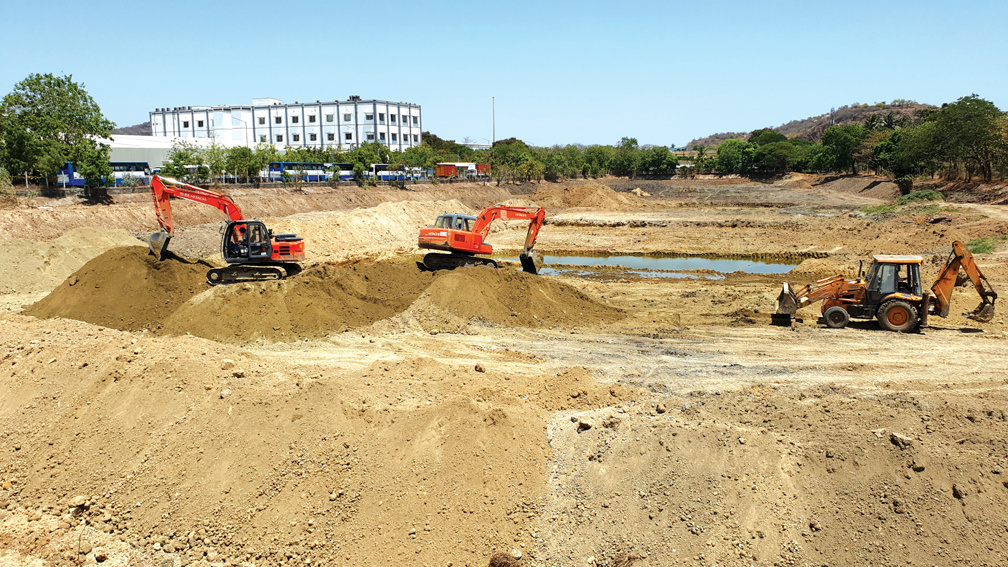
Lake restoration work in progress.
This is where lakes come into play. “With a restored water body (lakes), regulating the storm water into storage areas is possible. This prevents flooding in residential areas. Though hundred percent inundation free-zones may not be possible, because of the levels at which our city is positioned, the time taken for receding and storage can be improved,” says Arun Krishnamurthy, the founder of Environmentalist Foundation of India (E.F.I), an NGO based in Thiruvanmiyur. E.F.I has restored around 43 lakes in and around Madras since 2011, including Thamaraikeni Lake in Sholinganallur, Kannagi Nagar Lake in Thoraipakkam and Arasankazhani Lake in Perumbakkam.
Madras has a track record of oscillating back and forth from water crisis in summer to devastating floods in monsoon. In 2019, there was no rain for around six months, and the groundwater receded significantly. The city was parched with major reservoirs of Poondi, Cholavaram and Red Hills drying up. The city must buck up its lake-restoration processes to stabilise its groundwater reserves. “If not, we would continue to be victims of water shortage,” alerts Krishnamurthy.
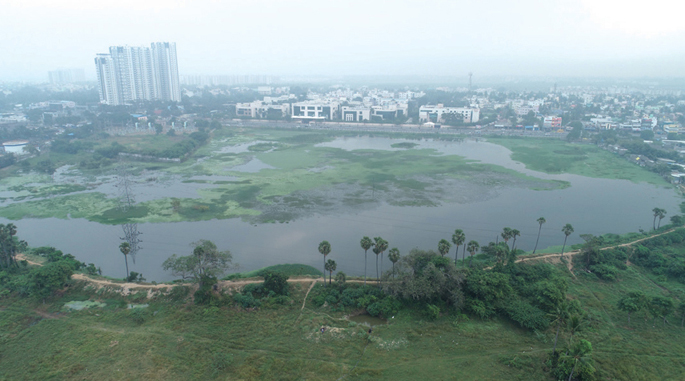
The Sholinganallur lake or Thamarai Keni Lake.
He walks us through the basics of lake restoration: “Lake restoration refers to the process of protecting a lake from current-day modern challenges and to revive it through scientific means. This includes steps to clean up the water body, recover its habitat characteristics and balance the hydraulics. The general process include cleaning the lake of trash, clearing the invasive weeds, deepening the water body to increase storage capacity based on its soil condition, strengthening the embankments and regulating the water’s inflow-outflow regions.”
“It is a time consuming process, that is not just restricted to desilting and making embankments,” remarks Jayashree Vencatesan, the managing trustee of Care Earth Trust, an NGO based in Nanganallur which is in the final leg of restoring the lakes of Thazhambur, Pudhuthangal and Sembakkam.
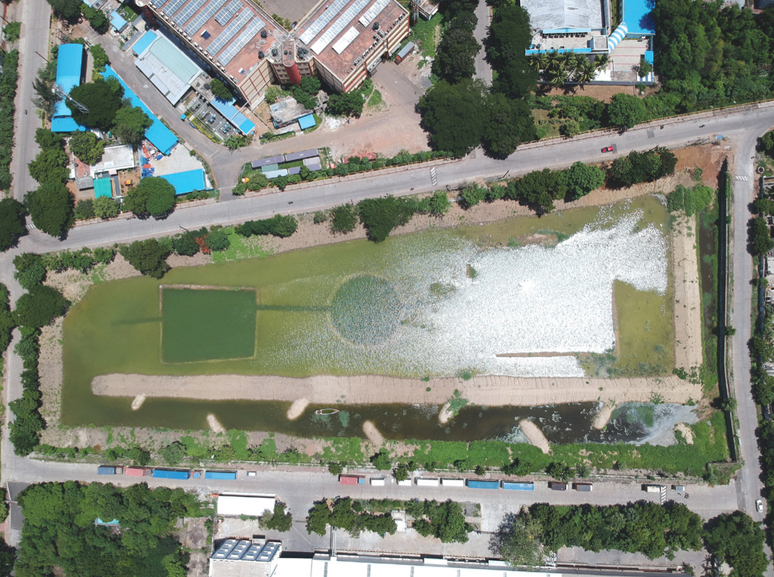
Alleri Tank, Located within the M.E.P.Z, West Tambaram, Chennai.
“Dumping solid-liquid waste and construction debris, along with encroaching on lake-water holding area for construction have led to the destruction of several lake ecosystems in Chennai. This has led to loss of biodiversity, emergence of health-related issues for residents living adjacent to the lake and loss of pure drinking water,” reveals the E.F.I founder. The duration required to restore varies from lake to lake as per the restoration goal. Natural healing and cleansing is the only fool proof method which may take centuries: “We are only aiming at reviving lakes to modern day standards for optimum conservation possible in the current context,” he says. It will take one year for building embankments; and a minimum of three years to restore fifty percent of the lake. This involves reviving its original holding capacity, improving water quality and making sure there are no obstructions to the flow of water, elaborates Jayashree.
E.F.I revived Kannagi Nagar Lake in Thoraipakkam focusing on groundwater percolation, temperature regulation, constructing new bunds or embankments, deepening the water-holding area and putting up protective fencing to prevent dumping of trash in September 2020.
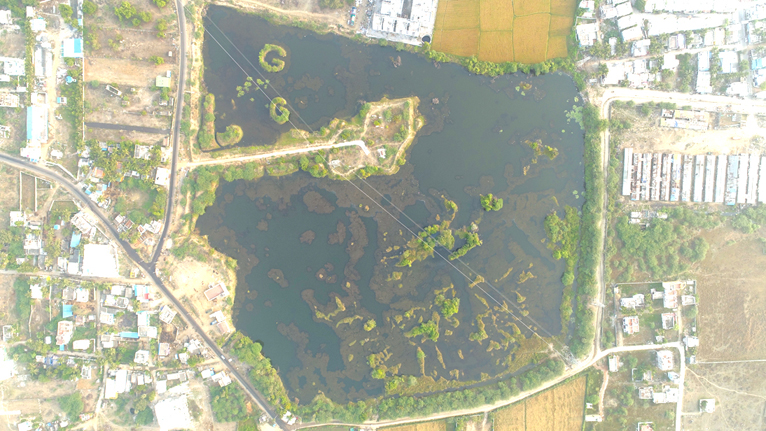
Arasankazhani Lake, G-Shaped islands, dual bunds, and parallel trenches were carried out during this restoration.
“The amount of funds depends on the state of wetland. For minimal disturbance, six lakhs is enough to restore a wetland of 10 hectares. But if the condition is problematic, then even 50 lakhs won’t make a difference,” she clarifies. The Tamil Nadu government launched the Kudimamaruthu scheme in March 2017 to restore the water-bodies in the state with the help of local community participation. Out of the 499 crore rupees estimate for Tamil Nadu under the scheme, Madras got 93 crores for management and restoration of water bodies, according to a GO issued in June 2019.
Even private organisations like Cognizant and Grundfos, which provides advanced pump solutions and water technology funded the restoration of water bodies, joining hands with Care Earth Trust, IIT Madras and The Nature Conservancy (one of the world’s largest conservation organisations). Business World reported on August 2020 that, Cognizant will contribute more than INR 2.7 crores and Grundfos will contribute INR 1.7 crores and up to INR 7.5 lakhs in kind for civil works, wastewater treatment, and landscaping to rejuvenate the 100-acre lake that flows into the Pallikaranai wetland, one of south India’s last remaining natural marshlands.
“The biggest mistake is to treat all the waterbodies in the same way. They are different in terms of their structure, hydrology, functionality, terrain and location. We assess the site with the help of a combination of experts before beginning the restoration process. The difficulty lies with the amount of time, efforts and resources that can be devoted to understanding the waterbodies,” answers Jayashree when asked about the hardships encountered in restoring lakes.
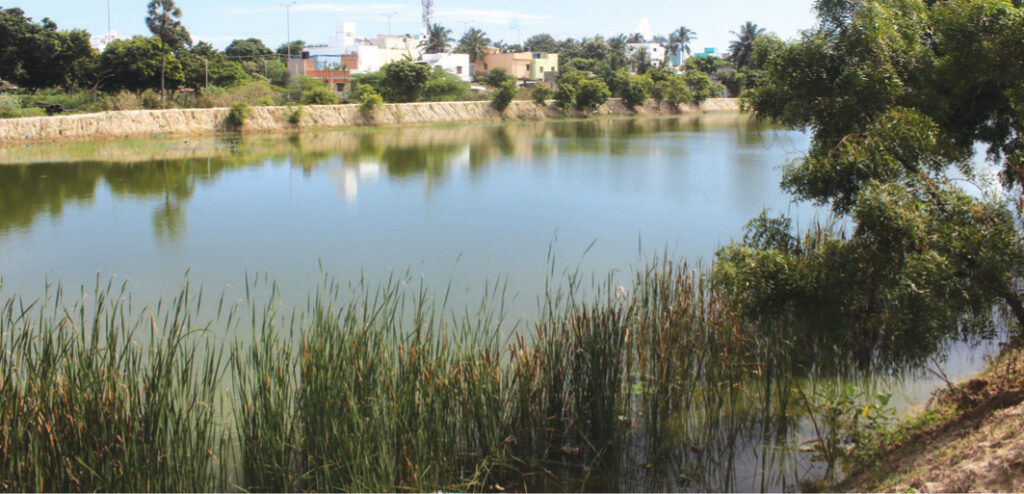
Uzhavarkeni Thangal ECR, shot after restoration.
Krishnamurthy urges people to talk about water bodies to gain more awareness, and participate in volunteering efforts to maintain a neighboring lake or pond. “You can make sure pollution from the flat doesn’t enter the water body. Install dual plumbing. Reuse and recycle the grey water that comes out of the building,” advises Jayashree.
Lake restoration not only helps people to alleviate water-shortage and flooding, but also helps to bring back biodiversity. Wetland plants and animals are reemerging. Medicinal plants like brahmi and green leafy vegetables are seen growing near the lakes. Habitats have been created for amphibians, reptiles and birds like spot-billed pelicans and painted storks: “They sit there as if they own the place,” laughs Jayashree.

